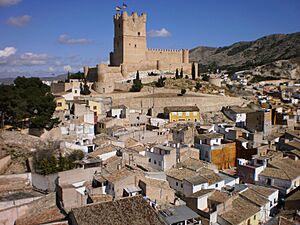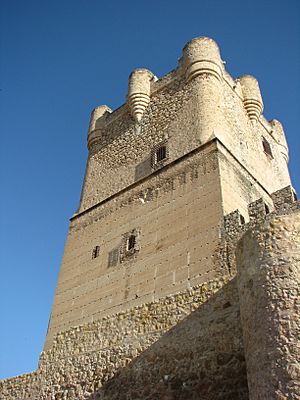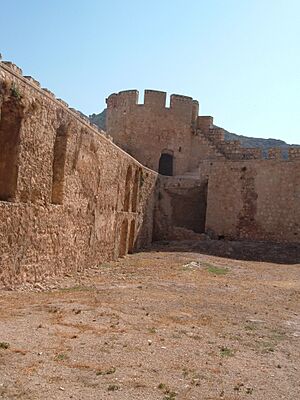Atalaya Castle (Spain) facts for kids
The Atalaya Castle (also known as Castillo de Villena) is a strong fortress in Villena, a town in southern Spain. It sits on a hill in the Sierra de la Villa mountains. This castle was once very important because it guarded the border between the old kingdoms of Castile and Kingdom of Aragon.
History of the Castle
No one knows exactly when the Atalaya Castle was built. But we know it existed by the 12th century, as Arab writings mention it in 1172. Some people think it might have been built on top of an old Roman fort, but there's no proof of that yet.
The castle was a key defense point on the northern edge of the Muslim lands in Spain. It was so strong that James I of Aragon tried to capture it three times! He finally succeeded in 1240. His army, led by knights from the Order of Calatrava, took the castle.
However, Villena was supposed to belong to Castile, according to an earlier agreement. So, after the Treaty of Almizra in 1244, the castle officially became part of the Kingdom of Castile.
It was first given to the Order of Calatrava. But soon, Prince Manuel became the lord of Villena and took ownership. His son, the famous writer Juan Manuel, Prince of Villena, lived here. He made changes to the castle to make it even safer, especially to protect his future wife, Princess Constanza of Aragon. Later, in the 14th century, the castle passed to Alfonso of Aragon and Foix, who was the first Marquis of Villena.
In 1476, the people of Villena, with support from the Catholic Monarchs, rebelled against the marquises. After this, the castle was no longer a home for the marquises. It became a royal castle, belonging to the king and queen.
During a time of rebellion called the Revolt of the Brotherhoods (1519–1523), a leader named Diego Mendoza hid in the castle. From here, his troops helped bring back royal power in Valencia. Later, during the War of Spanish Succession (1701–1713), 50 soldiers loyal to the Bourbon family defended the castle for eight days against a much larger army.
The castle was left empty after French Marshal Suchet looted it during the Peninsular War in the early 1800s. The first restoration work on the castle happened in 1958. Today, the castle is in good shape. It's a central part of the yearly Moros y Cristianos festival, which celebrates the history of Christians and Moors in Spain.
The Atalaya Castle was declared a Historical-Artistic Monument in 1931, meaning it's a protected historical site.
What the Castle Looks Like
The main entrance to the castle faces northwest. There were two other entrances, but they are now closed. Along the top of the outer wall, there's a chemin-de-ronde, which is a walkway for guards. This path connects all the towers. Inside the inner gate, archaeologists have found remains that might belong to a old church.
The castle has a "concentric" design, meaning it has walls within walls. There's an inner, taller set of square walls. Outside this, a rectangular barbican (an extra defense area) creates a larger space in front of the main tower. The inner square has round towers at its corners, except for one corner where the keep stands. These inner walls were built a long time ago by the Almohad people. In the 15th century, Don Juan Pacheco ordered them to be covered. Above this section, another path leads to the keep. The keep and the towers have rectangular merlons, which are the solid parts of the castle wall's top.
The keep is much taller than the other parts of the castle. Its lower sections were built by the Almohads using a technique called rammed earth, which uses packed dirt. A small entrance leads into a large hall, about 7 by 7 meters. The walls of this hall are very thick, about 3.5 meters! The hall has an Almohad ceiling from the 12th century.
The stairs going up to the higher parts of the keep have a copy of a graffiti drawing of a khamsa. A khamsa is a hand-shaped symbol often used for protection. The original drawing is in Villena's museum. The middle hall also has an Almohad ceiling. The two top sections of the keep were built in the mid-15th century.
See Also
 In Spanish: Castillo de la Atalaya para niños
In Spanish: Castillo de la Atalaya para niños
- Route of the Castles of Vinalopó
- Camino del Cid
- History of medieval Arabic and Western European domes





